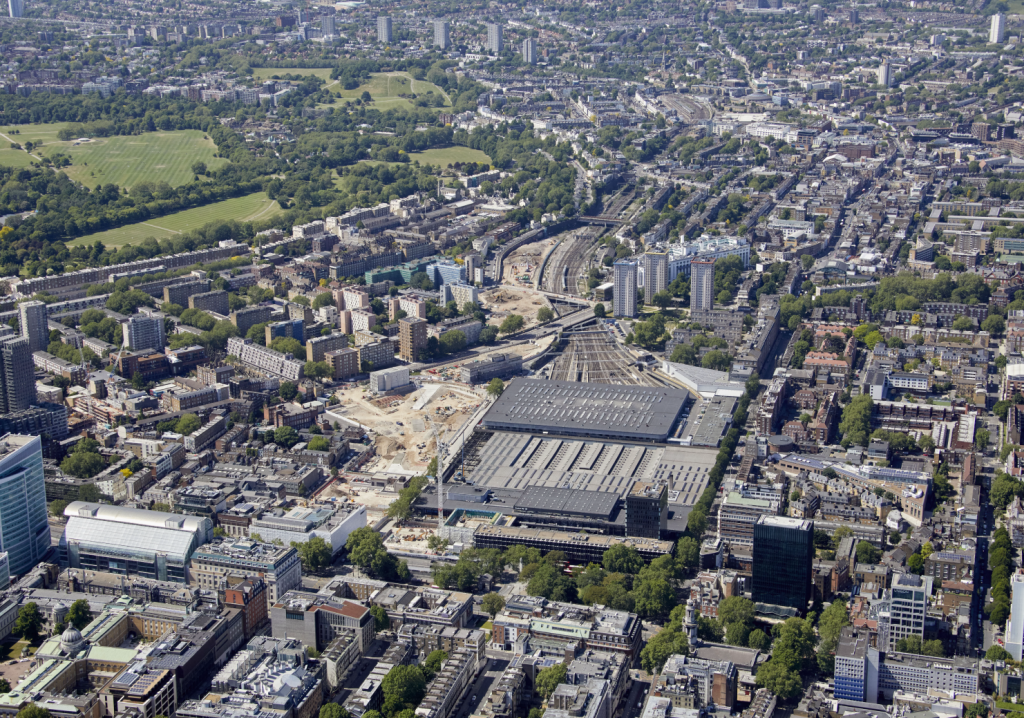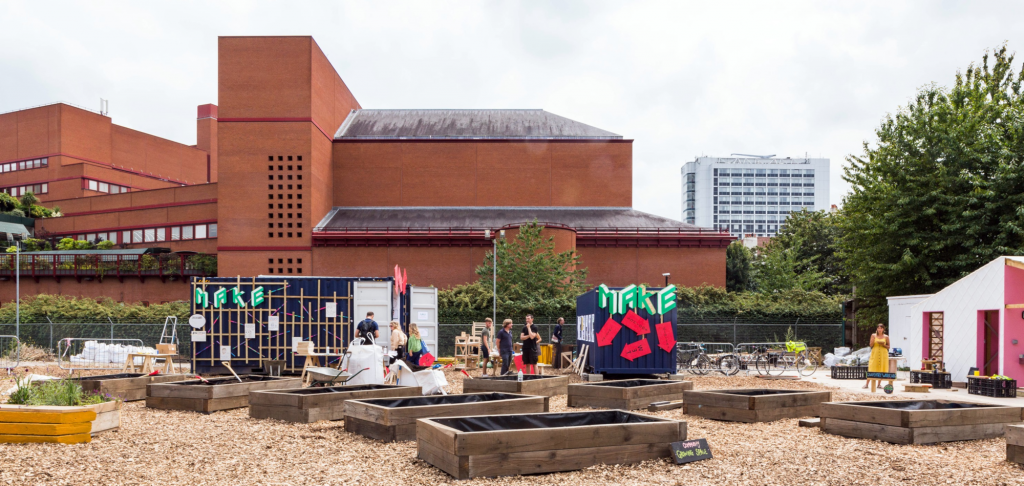Toolbox in Action
Explore how participatory meanwhile interventions unfolded in the context of seven regeneration initiatives across Europe & Asia.
Particularly suggested for policy-makers, practitioners, and researchers.
About
Euston London
Euston is located within the London Borough of Camden, on the Northern edge of central London. The area is predominantly known as a main transport hub for London, used by approximately 50 million passengers each year.
Surrounding Euston station are densely populated residential areas with a high percentage of social housing, such as Somers Town and Regents Park Estate. London Euston also neighbours the ‘Knowledge Quarter’, a large network of over 100 partner organisations of different kinds including academic, cultural, research, scientific and media organisations. Euston Road to the South of the station is a main route across London, and is therefore busy with traffic and pollution. In its current formation, Euston station creates a harsh geographical divide between the East and West sides of the station, completely cutting these residential areas off from one another, with few routes across.
Despite its proximity to the centre of London, the residents of Euston continue to face many social, economic, and environmental barriers. However, the area is also characterised by a strong sense of community especially within neighbourhood pockets, and there are many local organisations working to alleviate specific issues, alongside Camden Council.
Euston’s Redevelopment
The Euston Area Plan (EAP) sets a clear vision for the area in 2031: “The Euston area will be rejuvenated as both a local hub of activity and a gateway to London through new high quality comprehensive and transformational development above and around a world class transport interchange at Euston Station”. One of the key projects to achieve this vision is the HS2, the new high speed railway terminus station that will serve as a transport superhub acting as a gateway to the North of the country. The HS2 is envisioned as a world-class ‘infrastructure led regeneration project that will more than double the capacity of Euston station in peak hours, free up space for local and long distance commuter services and improve the connection with the London Underground’.
The Over Station Development (OSD) will reconnect the neighbourhoods that have been separated by the railway infrastructure by building above, between and around Euston’s HS2 and the Network Rail Stations. In doing so, the OSD aims to have positive long-term impacts in a number of areas including: Increasing the housing supply, including affordable homes; offering more and better parks and open spaces; improving the connections between surrounding streets and neighbourhoods; creating new jobs; reducing noise and pollution; and creating new amenities, community, leisure and entertainment facilities. CrossRail 2 is envisioned as a contemporary transport hub that will connect the stations in the North-East and South-West of Greater London. Lastly, the re-development of the existing Network Rail station will increase the capacity of the station to get passengers to where they need to be more effectively and efficiently
Numerous parties are involved in Euston’s redevelopment. In 2020, the Euston Partnership was established with the sponsorship of the Department for Transport, in order to enable a better governance system that would act as a single gateway for overseeing all works in Euston. The Partnership consists of members from High Speed 2 Limited, the Department for Transport, Camden Borough, Lendlease, Transport for London, the Greater London Authority and Network Rail. Currently, the masterplan is in development, and there is little information available about the specifics of the OSD.
Challenges and opportunities for Meanwhile intervention
Within T-Factor, the overall challenge of the Euston pilot is understood as ‘leveraging temporary uses to demonstrate and bring forward the benefits of inclusive, equitable and regenerative development’. Despite its central location, parts of Euston are some of the most disadvantaged areas within the London Borough of Camden. The arrival of HS2 and the vast changes to this already challenging situation have further impacted on the lives of those living and working in the area, and this will continue for another thirty years. Within this context, temporary uses can be a way to demonstrate the possibilities, and explore the potential, to bring forward the benefits of the development to those who already live and work in the area. The intention is to eventually contribute to the wider masterplanning and policy-making for these areas, towards inclusivity, equality and regenerative practices that improve quality of life in the short to medium term.
City: London
Country: United Kingdom
Location: London Borough of Camden
Scale: 24 Hectares
Investment: Envisaged investment of £5.6 billion
Governance: Euston Partnership (High Speed 2 Limited, the Department for Transport, Camden Borough, Lendlease, Transport for London, the Greater London Authority and Network Rail)
Timeline: 2026 – 2040



Privacy Overview
| Cookie | Duration | Description |
|---|---|---|
| cookielawinfo-checkbox-analytics | 11 months | This cookie is set by GDPR Cookie Consent plugin. The cookie is used to store the user consent for the cookies in the category "Analytics". |
| cookielawinfo-checkbox-necessary | 11 months | This cookie is set by GDPR Cookie Consent plugin. The cookies is used to store the user consent for the cookies in the category "Necessary". |
| CookieLawInfoConsent | 1 year | Used to save user's preferences about the cookies. |
| PHPSESSID | session | Preserves user session state across page requests. |
| viewed_cookie_policy | 11 months | The cookie is set by the GDPR Cookie Consent plugin and is used to store whether or not user has consented to the use of cookies. It does not store any personal data. |
| Cookie | Duration | Description |
|---|---|---|
| _ga | 2 years | This cookie is set by Google Analytics. It is used to identify unique users and it expires after 2 years. |
| _gat | 1 minute | This cookie is set by Google Analytics. It is used to by Google Analytics to throttle request rate. |
| _gid | 24 hours | This cookie is set by Google Analytics. It is used to identify unique users and it expires after 24 hours. |